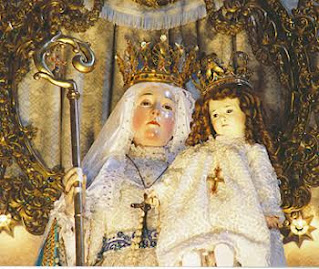STORY OF OUR LADY OF OVIEDO
Feast Day - May 2 (711)
Where some of the Blessed Virgin Mary’s hair is kept
The Cathedral of Oviedo was founded in 781 AD, and enlarged by Alfonso the Chaste, wh Io made Oviedo the capital of the Kingdom of Asturias. The chapel was once called Sancta Ovetensis, owing to the quantity and quality of relics contained in the Camara Santa (Holy Chamber).
“There is in the city of Oviedo a Holy Chest that contains many and varied relics. It rests in the town where King Alfonso II, the Chaste, built a shrine to house it, and there it can be seen even today as it was well over a millennium ago. Like the Arc of the Covenant, or the Holy Grail, it is a singular thing the like of which is almost utterly unknown in the entire history of mankind.
This Holy Chest is made of oak and was skillfully constructed without the use of any nails. It measures roughly four feet by three feet by two feet, and has been venerated by faithful Catholics since apostolic times. Indeed, it is believed to have been fashioned by devoted disciples of the twelve apostles. Many men and women throughout history have given their entire lives in service to the holy relics contained therein, or to save the chest from pagans who sought its destruction.
The chest took its roots in Jerusalem. When the Persian’s attacked and conquered Jerusalem in 614, many priceless relics from the region were gathered and placed in it for protection, as the Persians sought relics to destroy them. The chest was taken for safekeeping to a small community of Catholics in Alexandria, Egypt. A short time later, Alexandria was also ransacked by the Muslims, and the chest was taken across the Mediterranean Sea to Spain, where Saint Isidore kept it in Seville. Upon Isidore’s death, the chest was transferred to the city of Toledo, which was then becoming an important center in Spain. When the wave of Muslim aggression reached even Toledo in 711, the Holy Chest was taken to the Asturias and hidden in a Well in Pelayo mountain.
The chest has a lock and key, but by the time of the eleventh century it had not been opened for hundreds of years. The last time it was known to have been opened was when it was done by a living Saint, Ildephonsus, when he placed in it a chasuble that Our Lady herself had given him in an apparition.
By 1030 AD, the exact contents of the Holy Chest were no longer known. Bishop Ponce of Oviedo, and many other clerics, determined to unlock the secrets of the chest. As soon as the lid was raised a little, “there burst forth so magnificent light that terrified the clerics. Some of them stricken stone-blind, dropped the lid and fled, leaving the mystery unsolved.”
On Friday, March 13, 1075, after Mass, the key was again placed in the lock. On this occasion, God was pleased to reveal the contents of the Holy Chest. The chest contained the Sudarium, mentioned by Saint John the Evangelist in his Gospel as the cloth that covered the face of Christ after the crucifixion. On it can be seen the bloodstains of Our Lord that proved his passion and death. This alone is a treasure without reckoning…
The chest also houses a piece of the True Cross of Our Lord Jesus Christ, a small stone of the sepulcher in which He was buried, some of the cloths in which He was swaddled in the manger, several thorns from the Crucifixion scene, a piece of the earth of Mount Olivet touched by His feet when He ascended into heaven, one of the thirty silver coins given to Judas, the chasuble given by the Blessed Virgin Mary to Saint Ildephonsus, a chest of gold and precious stones containing the forehead of Saint John the Baptist and his hair, and a host of other relics from many saints and prophets, including Saint Stephen, the first martyr, Saint Mary Magdalene, Saint Peter the Apostle, Saint Vincent, and the staff of Moses which parted the Red Sea and the manna from heaven during the Exodus from Egypt, and many other priceless relics.
King Alfonso VI ordered a silversmith to protect the Holy Chest in gilded silver, beautifying it with figures of Our Lord and His Angels and Saints. Till today it can still be seen.





Post a Comment